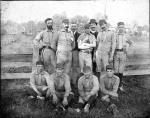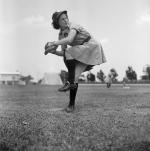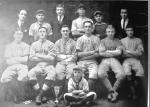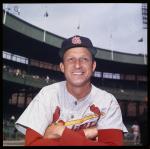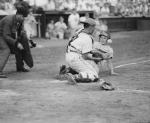Chapter Four: Small Town Baseball
Once upon a time, the National Pastime was just that: the most widely-played game in just about every town and the most popular of all spectator sports.By the late nineteenth century, its appeal had apparently seeped into every nook and cranny of the nation. How could it not? "It's our game, America's game," wrote poet Walt Whitman with great verve. "It belongs as much to our institutions, fits into them as significantly, as our Constitution's law; is just as important in the sum total of our historic life." The game, it seemed, fit a changing America, and America fit the game.
Baseball has always been a game that can be played anywhere there is an open field or a vacant lot, as long as someone brings a bat, a ball, and something to mark the bases. The object and the rules have remained relatively simple, and the game itself offers good, healthy exercise to both young and old alike.
As the game spread, virtually every hamlet, village, and town had a team of its own, and sometimes more than one. Made up of many of the best players in the area, these local teams quite literally wore their pride on their chests when they went out to battle neighboring nines from neighboring towns, sporting uniforms with letters of their hometown's name. More than just a group of guys or gals out playing a game, these teams became unifying threads in the fabric of their communities.
Many teams first formed around the specific ethnic, class, and racial identities of their communities. The opportunities to play other teams from other communities often exposed them to identities and backgrounds different from their own. Competition on the baseball field helped build respect that could ease the class and ethnic divides that players faced off the field. For many, the baseball bat turned into an important tool for stirring the American melting pot.
Communities supported their teams with both their passion and their pocketbooks. They built grandstands and tended the field, and shouted encouragement until they had no voice left. Long before television, whole towns turned out to watch important games; the ball field became another version of the town square, a place to see and be seen. It was not unusual for local businesses to sponsor teams of their own, and to offer better jobs to the best players in order to keep them happy and in the community.
As people acquired more leisure time, the game spread. Throughout Pennsylvania, local teams sprouted up and baseball leagues soon followed. Local leagues played for civic pride and physical joy, their teams sponsored by everything from churches and civic organizations to politicians and small businesses. Industrial leagues emerged in an attempt to instill corporate pride and build camaraderie among workers in the steel mills around Pittsburgh, the mines of the northeast coal country, and the factories and trades everywhere. When it became clear that baseball could be a profitable business in its own right, the minor leagues proliferated throughout Pennsylvania, too, finding homes in Altoona, Allentown, Butler, Erie, Lancaster, Reading, Scranton, Williamsport, and Harrisburg.
As railroads crisscrossed the state and made travel easier, even the smallest town teams could take extended road trips to play more distant opponents. The telegraph wired home the final scores almost instantaneously. Honing their skills in pick-up games on sandlots, farm fields, or village greens, young boys dreamed of playing alongside their older brothers and fathers on the town team; of playing for a semi-pro team, or even making it to the major leagues. Indeed, with the birth of organized professional leagues in the late 1860s, the dream of playing baseball for a living became a reality. For those who truly excelled in the game, a new career door opened–and it beat breaking your back on a farm or tending yarn spools in a mill. Baseball was healthy, outdoor work, even if it paid a living wage only to the top stars.
In the late nineteenth and early twentieth centuries, Pennsylvanians like John Montgomery Ward,
John Montgomery Ward,  Ed Walsh
Ed Walsh  Rube Waddell,
Rube Waddell,  Christy Mathewson, Herb Pennock,
Christy Mathewson, Herb Pennock,  Pete Gray, and Stan Coveleski strode through that professional baseball door. All talented athletes, they caught the game's bug early, played on local teams, and rode the game to national fame and recognition in baseball's Hall of Fame in Cooperstown. Even a kid like
Pete Gray, and Stan Coveleski strode through that professional baseball door. All talented athletes, they caught the game's bug early, played on local teams, and rode the game to national fame and recognition in baseball's Hall of Fame in Cooperstown. Even a kid like  Eddie Plank from Gettysburg, who really didn't care much for baseball, couldn't help but notice that the game was being played all around him. With the encouragement of his college coach, Plank went on to become one of the most successful left-handed pitchers in the major leagues. And he wasn't the only baseball star to come from a rural Pennsylvania town.
Eddie Plank from Gettysburg, who really didn't care much for baseball, couldn't help but notice that the game was being played all around him. With the encouragement of his college coach, Plank went on to become one of the most successful left-handed pitchers in the major leagues. And he wasn't the only baseball star to come from a rural Pennsylvania town.  Nellie Fox would also join him in the Baseball Hall of Fame, as would Stan Musial, from industrial Donora.
Nellie Fox would also join him in the Baseball Hall of Fame, as would Stan Musial, from industrial Donora.
For every baseball player who's made it to Cooperstown, there have been thousands who've loved the game but never played beyond the small fields of a St. Thomas, a Donora, a Bellefonte, a Shamokin or a Factoryville. Carl Stotz, from Williamsport, was one of them. He loved watching the local minor league team play at
Carl Stotz, from Williamsport, was one of them. He loved watching the local minor league team play at  Bowman Field, but wondered why there were no manicured diamonds and organized leagues for children. It wasn't long before Stotz conceived Little League baseball, which still plays its annual World Series in South Williamsport every year.
Bowman Field, but wondered why there were no manicured diamonds and organized leagues for children. It wasn't long before Stotz conceived Little League baseball, which still plays its annual World Series in South Williamsport every year.
Since World War II, the baseball landscape has changed. Today, Little League is the only league still thriving in most small towns. Once unchallenged as the National Pastime, baseball in the twenty-first century competes with everything from soccer and computers to concerts and video games for our time, our attention, and our loyalty.Instead of turning out en masse to the local field to watch friends and neighbors play, today's baseball spectator is largely content to view a major league contest in the solitary comforts of the living room, perhaps disheartened by today's steep ball park admission prices and increasingly lured by the sheer ease of cable or network television.
Small town baseball, however, remains alive and well in Pennsylvania. High school, college, and amateur teams have, in recent years, been joined by senior leagues that thrive throughout the state.
Baseball has always been a game that can be played anywhere there is an open field or a vacant lot, as long as someone brings a bat, a ball, and something to mark the bases. The object and the rules have remained relatively simple, and the game itself offers good, healthy exercise to both young and old alike.
As the game spread, virtually every hamlet, village, and town had a team of its own, and sometimes more than one. Made up of many of the best players in the area, these local teams quite literally wore their pride on their chests when they went out to battle neighboring nines from neighboring towns, sporting uniforms with letters of their hometown's name. More than just a group of guys or gals out playing a game, these teams became unifying threads in the fabric of their communities.
Many teams first formed around the specific ethnic, class, and racial identities of their communities. The opportunities to play other teams from other communities often exposed them to identities and backgrounds different from their own. Competition on the baseball field helped build respect that could ease the class and ethnic divides that players faced off the field. For many, the baseball bat turned into an important tool for stirring the American melting pot.
Communities supported their teams with both their passion and their pocketbooks. They built grandstands and tended the field, and shouted encouragement until they had no voice left. Long before television, whole towns turned out to watch important games; the ball field became another version of the town square, a place to see and be seen. It was not unusual for local businesses to sponsor teams of their own, and to offer better jobs to the best players in order to keep them happy and in the community.
As people acquired more leisure time, the game spread. Throughout Pennsylvania, local teams sprouted up and baseball leagues soon followed. Local leagues played for civic pride and physical joy, their teams sponsored by everything from churches and civic organizations to politicians and small businesses. Industrial leagues emerged in an attempt to instill corporate pride and build camaraderie among workers in the steel mills around Pittsburgh, the mines of the northeast coal country, and the factories and trades everywhere. When it became clear that baseball could be a profitable business in its own right, the minor leagues proliferated throughout Pennsylvania, too, finding homes in Altoona, Allentown, Butler, Erie, Lancaster, Reading, Scranton, Williamsport, and Harrisburg.
As railroads crisscrossed the state and made travel easier, even the smallest town teams could take extended road trips to play more distant opponents. The telegraph wired home the final scores almost instantaneously. Honing their skills in pick-up games on sandlots, farm fields, or village greens, young boys dreamed of playing alongside their older brothers and fathers on the town team; of playing for a semi-pro team, or even making it to the major leagues. Indeed, with the birth of organized professional leagues in the late 1860s, the dream of playing baseball for a living became a reality. For those who truly excelled in the game, a new career door opened–and it beat breaking your back on a farm or tending yarn spools in a mill. Baseball was healthy, outdoor work, even if it paid a living wage only to the top stars.
In the late nineteenth and early twentieth centuries, Pennsylvanians like
For every baseball player who's made it to Cooperstown, there have been thousands who've loved the game but never played beyond the small fields of a St. Thomas, a Donora, a Bellefonte, a Shamokin or a Factoryville.
Since World War II, the baseball landscape has changed. Today, Little League is the only league still thriving in most small towns. Once unchallenged as the National Pastime, baseball in the twenty-first century competes with everything from soccer and computers to concerts and video games for our time, our attention, and our loyalty.Instead of turning out en masse to the local field to watch friends and neighbors play, today's baseball spectator is largely content to view a major league contest in the solitary comforts of the living room, perhaps disheartened by today's steep ball park admission prices and increasingly lured by the sheer ease of cable or network television.
Small town baseball, however, remains alive and well in Pennsylvania. High school, college, and amateur teams have, in recent years, been joined by senior leagues that thrive throughout the state.







